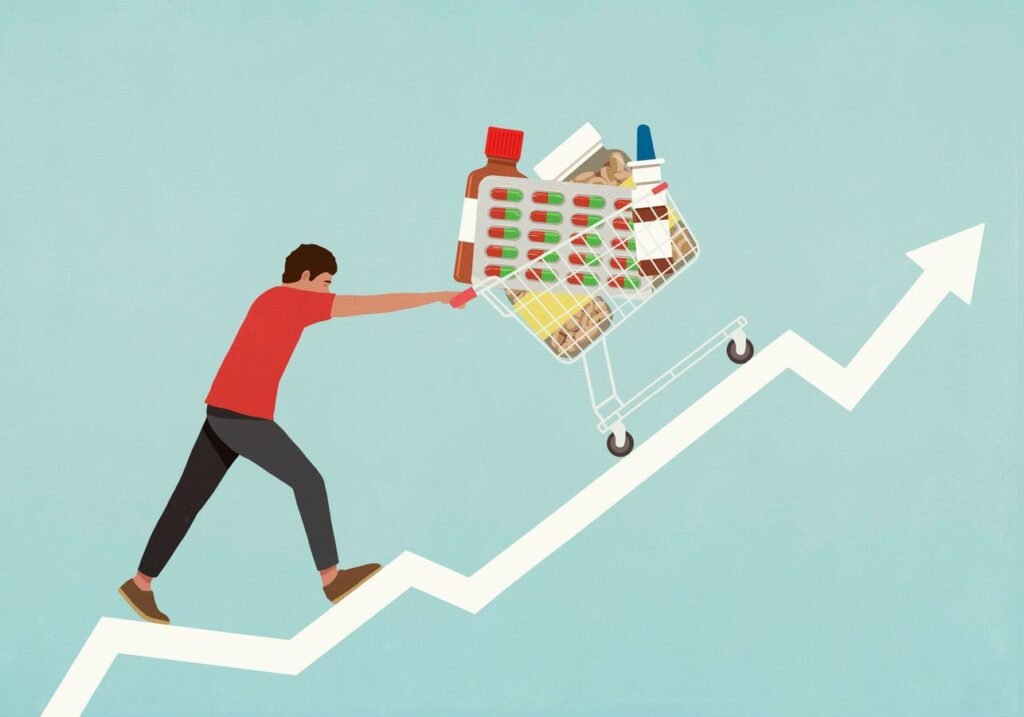NEW YORK, NEW YORK – JULY 23: Prescription drugs are displayed at NYC Discount Pharmacy in Manhattan on July 23, 2024, in New York City. In the U.S. drug market, higher list prices can paradoxically look like savings. (Photo by Spencer Platt/Getty Images)
Getty Images
America’s largest companies are among the toughest negotiators in global commerce. They pressure suppliers, scour contracts for waste and squeeze costs wherever they can. Yet in prescription drugs, these same companies participate in a system that makes them — along with brokers, pharmacy benefit managers and drugmakers — effectively happier when list prices go up.
If a Fortune 100 CFO applied the same logic to any other part of the business, they’d be fired. That’s the strange economics of the rebate system that dominates how large employers pay for medicines.
The Rebate Illusion
Most big employers don’t buy health insurance off the shelf. They “self-insure,” hiring an insurer and a pharmacy benefit manager to administer claims. Aiding them in this process are large benefits consulting firms such as Aon, Marsh McLennan and Willis Towers Watson. In these contracts for drugs, what gets measured — and guaranteed — frequently isn’t the net cost of medicines but the size of the rebate check that the PBM promises to deliver back at year’s end.
To see how odd this logic becomes, consider a simple example. Suppose a drug has a list price of $1,000. The pharmacy benefit manager negotiates an $800 rebate from the manufacturer. The employer pays $200 net, then later receives a large rebate check and congratulates itself on the savings. Now imagine the price rises to $1,100 and the rebate rises to $900. The net price is still $200, but the rebate check is bigger, and the employer feels like it got an even better deal. In truth, nothing about the underlying economics improved. Research shows a near one-to-one relationship between list price and rebate amount. Net cost is what matters, but rebate dollars are what get celebrated.
It’s the corporate version of being thrilled about your IRS refund. Bigger refund, bigger smile, even though it only proves you overpaid in the first place.
Who Keeps the Game Going
Only a small slice of drugs — roughly 100 brand-name medicines in classes like insulin, asthma inhalers, biologics for arthritis and the new GLP-1 diabetes drugs — generate the vast majority of rebates. Because they’re so expensive, they drive a disproportionate share of spending. In a system where rebate dollars are the target, PBMs have every reason to prefer drugs with the biggest rebates, which are the ones with the highest list prices. That preference can override alternatives with smaller rebates, even when the net price to the employer is the same or lower.
This rebate illusion persists because every player in the system has a reason to keep it alive. Employers like visible rebate checks, which are easy to show in budgets and board reports. Brokers and benefits consultants reinforce rebate-centric contracting by writing RFPs that highlight guaranteed rebate dollars, which are clean, auditable and easy to benchmark. PBMs didn’t stumble into this arrangement; they designed it. Controlling formularies, they thrive on rebate-driven competition. Even if most rebate dollars today are passed through to payers, PBMs profit from administrative fees and other manufacturer payments that grow alongside list prices. And drug manufacturers lean in, launching new medicines with ever-higher sticker prices precisely to fund ever-bigger rebates that secure preferred formulary placement.
To be clear, the system hasn’t derailed everything. Generics still make up about 90% of all prescriptions, because their savings are overwhelming and there are no rebates to chase. But in the classes driving cost growth, the rebate game distorts choices and props up America’s uniquely high list prices.
The Real Cost to Patients
The one group that doesn’t benefit is patients. Those without insurance or in high-deductible plans pay based on list price, not the net price negotiated behind the scenes. Even insured patients can be steered toward a higher-list-price, higher-rebate drug rather than a lower-cost biosimilar. And when new drugs launch at inflated list prices, the cycle ratchets upward for everyone.
The consequences ripple outward. The rebate game slows biosimilar and generic adoption, inflates premiums and diverts innovation toward products that maximize rebate potential rather than net affordability.
TrumpRx and the Fiction of List Prices
The launch of “TrumpRx,” the administration’s proposed platform linking patients to drug company discount programs, unintentionally underscored this very point. If manufacturers can suddenly sell medicines directly to consumers at steep discounts, what does that say about the prices everyone else has been paying? It confirms what the rebate system already makes clear: list prices for many brand-name drugs are largely fictional.
Those inflated sticker prices exist mainly to support the rebate machinery that keeps PBMs, brokers, and even employers comfortable with the illusion of savings. Direct-to-consumer discounts may look like generosity, but they simply bypass one layer of intermediation without fixing the underlying problem — an opaque pricing structure built on inflated numbers that few people actually pay.
A Better Way Forward
It doesn’t have to be this way. Some large employer coalitions — like the National Alliance of Healthcare Purchaser Coalitions and the Purchaser Business Group on Health — are urging buyers to focus on net price and to demand “trend guarantees, not savings guarantees.” This doesn’t require new regulation, just better contracting. Employers can insist on full transparency about how their brokers and PBMs are paid and align those payments with net savings rather than rebate volume. A true fix will come only when buyers, brokers and PBMs compete on net spending trend, not the size of the rebate check.
Rebates were meant to control costs but have created a self-reinforcing ecosystem in which higher list prices please everyone except patients. The fix isn’t complicated: measure what matters. Until contracts revolve around net cost, not rebate size, America will keep cheering the refund that proves we overpaid.


